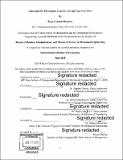| dc.contributor.advisor | Stephen Graves and David Simchi-Levi. | en_US |
| dc.contributor.author | Morrison, Ryan Cannon | en_US |
| dc.contributor.other | Leaders for Global Operations Program. | en_US |
| dc.date.accessioned | 2018-09-17T15:52:12Z | |
| dc.date.available | 2018-09-17T15:52:12Z | |
| dc.date.copyright | 2018 | en_US |
| dc.date.issued | 2018 | en_US |
| dc.identifier.uri | http://hdl.handle.net/1721.1/117974 | |
| dc.description | Thesis: M.B.A., Massachusetts Institute of Technology, Sloan School of Management, in conjunction with the Leaders for Global Operations Program at MIT, 2018. | en_US |
| dc.description | Thesis: S.M., Massachusetts Institute of Technology, Department of Mechanical Engineering, in conjunction with the Leaders for Global Operations Program at MIT, 2018. | en_US |
| dc.description | Cataloged from PDF version of thesis. | en_US |
| dc.description | Includes bibliographical references (page 57). | en_US |
| dc.description.abstract | The large multi-channel apparel distribution center was built as a purely wholesale building in the 1900s. With distribution becoming more complex due to e-commerce and smaller orders for more frequent replenishment, the requirements for the distribution center have changed significantly. The manner in which work flows through the building is influenced by batch size and release logic, which have not evolved to keep up with changing demand. Under the current flow of work, associates cannot stay busy working at the same processing (packing) station. Unstaffed processing stations are used as buffers, and associates move to unstaffed processing stations when they run out of work. The current flow prevents staffing all of the processing stations which significantly reduces the long-term throughput capacity. This thesis lays out a methodology to improve flow and unlock throughput capacity by changing batch size and control logic to meet future demand. The key enablers of this thesis were: 1) The collection of data to evaluate progress at key steps in the process 2) A holistic understanding of how the system functions, as well as the implications on the longterm throughput capacity | en_US |
| dc.description.statementofresponsibility | by Ryan Cannon Morrison. | en_US |
| dc.format.extent | 58 pages | en_US |
| dc.language.iso | eng | en_US |
| dc.publisher | Massachusetts Institute of Technology | en_US |
| dc.rights | MIT theses are protected by copyright. They may be viewed, downloaded, or printed from this source but further reproduction or distribution in any format is prohibited without written permission. | en_US |
| dc.rights.uri | http://dspace.mit.edu/handle/1721.1/7582 | en_US |
| dc.subject | Sloan School of Management. | en_US |
| dc.subject | Mechanical Engineering. | en_US |
| dc.subject | Leaders for Global Operations Program. | en_US |
| dc.title | Unlocking DC throughput capacity through improved flow | en_US |
| dc.title.alternative | Unlocking distribution center throughput capacity through improved flow | en_US |
| dc.type | Thesis | en_US |
| dc.description.degree | M.B.A. | en_US |
| dc.description.degree | S.M. | en_US |
| dc.contributor.department | Leaders for Global Operations Program at MIT | en_US |
| dc.contributor.department | Massachusetts Institute of Technology. Department of Mechanical Engineering | |
| dc.contributor.department | Sloan School of Management | |
| dc.identifier.oclc | 1051238226 | en_US |
